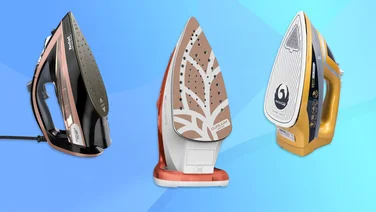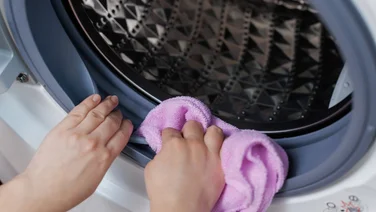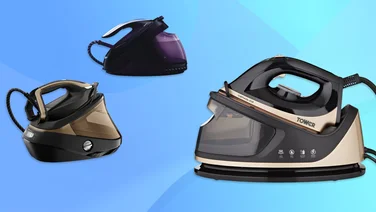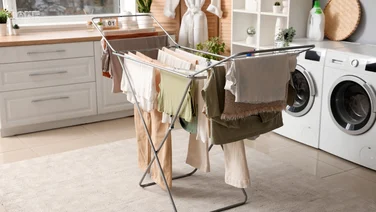To help us provide you with free impartial advice, we may earn a commission if you buy through links on our site. Learn more

We’ve all faced the problem of pulling an item of clothing out of the wardrobe, only to find it’s covered in wrinkles and creases. But what’s the best product to get rid of them – steam irons or garment steamers? Both have their place, says Hannah Hamer, assistant marketing manager at Russell Hobbs.
“Both steamers and irons are great at removing wrinkles, alongside refreshing your clothing. Ultimately, when it comes to choosing between them, it really comes down to the type of fabric you’re caring for, alongside the type of finish you’d like,” she explains.
“Garment steamers are great for more delicate fabrics and if you’re short of time, while steam irons are better suited for heavier fabrics and achieving precise, sharp creases.”
To help you decide whether a garment steamer or one of the best steam generator irons is right for you and your ironing needs, read on for our detailed comparison.
Steam irons vs garment steamers: What’s the difference?
You’d be forgiven for wondering how steam irons and garment steamers differ, seeing as they’re both handheld devices designed to eliminate wrinkles and creases. But in fact the two do work quite differently.
Steam irons use heat and pressure from the metal plates along the bottom (the soleplate) to remove creases and wrinkles. The heat is provided by electricity. Steamers, on the other hand, use both heat and moisture to smooth out clothes, drawing this from an attached water reservoir that’s set to a specific temperature.
Understanding symbols

Before you pick up either an iron or a steamer, just a quick note on checking your garment’s care label. These have laundry symbols on them clearly indicating what you can and can’t do when it comes to ironing.
- Iron symbol with a cross: Do not iron.
- Iron symbol with two lines shooting out the bottom and a cross through: Do not steam.
- Iron symbol with one dot: Iron cool (max 110℃) for delicate items like wool and silk.
- Iron symbol with two dots: Iron medium (max 150℃) for synthetics.
- Iron symbol with three dots: Iron hot (max 200℃) for linen and cotton.
READ NEXT: Best steam irons
When to use a steam iron
“A steam iron is a great fit when it comes to tackling the weekly ironing load as it will straighten out stubborn creases. A good iron with distilled water and a soleplate that defuses steam will glide effortlessly over an ironing board,” explains Komal Sawley, marketing manager at Tefal.Russell Hobbs’ Hannah expands on this further, “Steam irons are generally more effective on heavier, tougher and durable fabrics such as cotton, wool and linen. They’re also great for specific garments that require a sharper crease, such as suit trousers. What’s more, due to the soleplate, you can gain better heat distribution and a steam iron is a little bit easier to manoeuvre than a steamer.”
You’ll also get a wider choice when it comes to steam irons. Nowadays there are cordless options available for ease of use and steam generator irons with large water tanks for heavy duty ironing.
Steam iron pros
- They will give better results on heavier fabrics, such as cotton, denim and linen, due to the higher temperatures they can reach.
- You can iron bulky items, such as quilts and duvet covers.
- Irons are very precise, and the pointed tip makes them the best tool for creating sharp creases and reinforcing pleats.
- Irons give you greater control over the direction of heat.
Steam iron cons
- Irons get extremely hot, meaning it’s easier to burn clothes (or even yourself) if you don’t take sufficient care.
- They need an ironing board to iron on, meaning you need extra space for storage, as well as having to buy one.
- Delicate fabrics such as silks or chiffons can be burned by the heat, meaning you might need a separate steamer for them.
- Irons are bulky and difficult to transport and travel with – most hotels will have one in your room or provide one from reception if needed, though.
READ NEXT: Best clothes steamers
When to use a garment steamer
“Garment steamers are a great choice for those with limited time and space,” explains Hannah. “They’re quicker and easier to use than traditional irons as you can steam your clothing right on the hanger, with no ironing board required.
“They’re also great at dealing with those difficult-to-iron areas such as pleats and ruffles and can be used on a variety of different fabrics from silk to cashmere. Moreover, our Russell Hobbs handheld steamers have been designed to kill up to 99.9% of bacteria making them a more sustainable choice as there’s no need to wash after one use.”
Komal agrees, “A garment steamer operates more quickly than an iron and is an easy way to sharpen up a few outfits at a time thanks to its speedy heat-up time. Steamers are also useful when needing to rejuvenate clothes between washes as they eliminate odours and kill up to 99.9% of bacteria, which means fewer washes and less water and detergent is needed.
“They’re also smaller and more lightweight, so are ideal for travelling with and easy to store away in the home. Garment steamers can also be used on any fabric without causing any damage – which means even your most delicate items can be shown some love too.”
Garment steamer pros
- Steamers can be used on all fabrics with very little risk of damage because heat is applied delicately. This means you can use them on delicate fabrics such as silk and cashmere.
- They operate over a wide range of temperatures, generally 200-400℃ which means you can easily adjust the heat level depending on what fabric you’re steaming.
- You don’t need the added bulk of an ironing board and they’re easy to transport, so ideal for travelling.
- Steamers can be used on other fabrics around the home, not just clothes.
Garment steamer cons
- It usually takes longer to get out wrinkles with a steamer than with an iron, as the heat is diffused.
- As steamers don’t make direct contact with the fabric, they’re less effective at creating sharp lines for pleats or shirt cuffs.
- Steamers may struggle with thicker fabrics such as denim or corduroy.
- If you’re not careful, steamers can accidentally scald as hot steam passes through fabric causing burns on the other side.
READ NEXT: Best washer dryers






